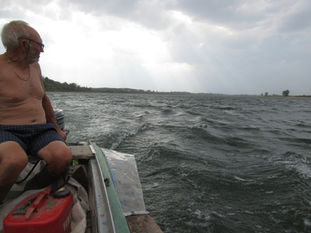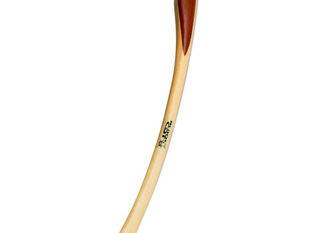
Food is a primary medium through which messages are related between family members (another one is vocalization of which later on). As we have seen in the previous post, the teaching of Rule 3 (‘Stand back, food will be brought to you’) is by look, shove, or shouting. In addition, these ‘stick’ measures are reinforced by a ‘carrot’ part: placing food in the wings, or taking it up to the family home.
The observation of this protective mechanism, targeting the youngsters, has been assisted by a tactic discovered by my father by pure chance. The tactic is humble and simple itself. It consisted of augmenting the family dinner by adding half a loaf of sliced bread. The idea is that a slice in the mouth of a carrier was well-seen by the camera. Oats carried could not be seen, a small fish, fish innards, vegetable peelings, etc. could be only dimly seen (or rather guessed). A slice of bread was another matter. It could be registered clearly enough. Carrying slices from bowl to the wings, or up to home, my father called ‘slicing’. This is how it looks:
Fig. 1. Taking slices up to home
As always, we pay attention to the context. It is 28 June at close to half nine, DST. In other words, this happens at the outer end of the prime slot and in denning time. The Mother is busy with the newborn pups. They are nearly a month and a half old by now, and in need of close care. The weather is calm and the river – being in high water – is close.
What we see is that the first to go ‘slicing’ up home is Big Ears – a dedicated helper. After he has gone up the home path, the Uncle tries a smaller piece, but then decides upon a slice. Up he goes after the junior.
Two minutes later, Big Ears is back at the bowl. He takes another slice and then he is off to the den and his mother. In the intervening two minutes he has been up to the den, left the slice, and has come back for more.
Fig. 2. Two minutes later
We need to reflect here that Rule 3 does not apply to this case. The need to help the Mother overrides all other considerations. While a junior is on such a mission, there should not be any chasing back into the wings. The food is not for them, it is for the Mother who is breastfeeding the rapidly growing pups.
Big Ears is also thinking about his sister – the smaller Big Ears. She is a very timid creature. She always stays in the wings (as in Fig. 2), never daring to cross the open space to the bowl. The bigger brother leaves food for her in the wings:
Fig. 3. Slices for sister
Slicing is either to the wings or all the way up to the den. But there is one other direction: to the riverbank. This is something done exclusively by the Uncle. In the following clip we see him take a slice with something hanging from it (which falls off). Slice in mouth, he trots off to the bank:
Fig. 4. Slicing to riverbank
My father thinks that a possible explanation is that food is being taken to those who are by the water edge. Golden Jackals like to drink water in the evening and also to wade in it. Since the event is in the post-denning period (after mid-July), and also after prime time (after 10 pm), it could be that the Mother is by the river with the pups. Regrettably, in the absence of a camera facing the bank this supposition cannot be verified.
Food ethic
There seems to exist an ethical rule saying that only the food left at the bait-site should be eaten. Over the years, my father noticed that the family would never steal food from the camp, or the ‘square’ in front of it. This amounted to an ethical rule saying ‘Never steal from the old man’s food.’ (Rule 4)
To begin with, what my father had in the way of food – cooked or stored - could not hold any secrets for the jackals. With their superb sense of smelling, they know what is there to the last crumb. Either under the roof of the tent, or on sun-drying planks in the ‘square’ in front of the tent.
The first time when my father noticed this peculiarity was when he put up a rack for drying small fish. The rack stood close by the river.

During the night, every single movement my father made under his mosquito net could be well heard, even his breathing (let alone snoring). Even at high water (as in the picture), the distance between his bed and the rack gave plenty of time for the swift-footed jackals to dive into the bush should they sense danger coming from the tent. And yet, the fish was never touched. In the morning, jackal tracks could be seen all along the bank and around the rack. But no fish was ever taken.
In 2020, my father moved the rack to stand at the foot of the bluff. He wanted to save himself the trouble of moving the rack up and down, following the constant rising and falling of the water-level. The new position was halfway between the tent and the bait-site, i.e., some 15 m away from the bowl. When we look at the picture below (Fig. 6), we can see the path going to the bait-site, and even see the bait-site itself (the whitish circle). Which means that a jackal going down the bluff and heading for the bait-site would practically brush the lowermost tier of fish. Despite this, not a single fish was ever pinched from the rack.

The fish is Danube mackerel of which more will be said below. When that fish was part of their dinner in the bowl, family and trespassers ate it avidly.
A contra-argument explaining the case – i.e., that there was no ethic rule or anything like that -would be that the jackals were behaving that way for fear of traps.
My father often thought about such an explanation. What could not be explained by fear of traps, however, was the case of the bowl. As said earlier on, in early bait-site history the senior adults vigorously checked the bait-site for a hidden trap by ‘twigging’. Gradually, the practice was abandoned and trust in the camp and its single inhabitant grew. There was always a chance of foul play (jackals are paranoically suspicious), but even they would decide at some point to resort to calculated risk. If the Mother is taking out her cubs to the bowl in full daylight close to the camp, an inevitable conclusion about measured trust is to be made. With food being regularly taken to the den in the course of over two months, she could not be so hungry not to wait for darkness – barely a couple of hours away. And yet, she takes out the cubs in open daylight.
Ultimately, jackals were ransacking human-made waste-dumps every night. This was from where they got over eighty percent of their diet. There was no way but to take chances in a calculated way. So, the existence of Rule 4 (‘Never take from the old man’s food’) seemed to be the truth.
Fishing
My father used gill-nets to catch fish. In the evening, he went out in his rubber dinghy and set them at the bottom of the river. An exception was a small-meshed surface net for catching uklei (Alburnus chalcoides). This small fish could be caught in quantity (3-4 kg/night). With such a catch there was enough for him and for the jackals.

The other fish which was most commonly caught was morunazh (vimba bream, Vimba vimba). My father grilled this tasty fish on the cooking range, while the heads and innards went for the jackals. From time to time, pike, perch-pike, catfish, and carp would be caught. Innards and leftovers from these bigger fishes were welcome additions to the jackal family dinner.

Karagioz (Danube mackerel)
It was mentioned earlier on that from 15 April until 1 June a ban on fishing was in force. An exception was made for the Danube mackerel (Pontic shad, Alosa immaculata), locally called by the Turkish word karagioz (black-eyed). Big shoals of the fish swam upriver to spawn in the shallows. The shoals attracted swarms of cormorants (Phalacrocorax carbo), whose columns of hundreds of diving birds would churn up the water.

The shoals of migrating fish also attract many different kinds of gulls, as also spectacularly – pelicans (Pelecanus):

But it is not only the water fowl who were attracted by the mackerel. Tens of anglers arrived from nearby towns, as well from the more distant Sofia. For about ten days, while the mackerel shoals offered good catches, the bank around the fishing port of Stanevo was dotted by small tents and even caravans. From year to year the number of the visitors differed, but an average of around fifty can be named.
For the several jackal families living along the bank, the Spring anglers’ invasion was of great moment. This was exactly at the time when jackal mothers gave birth to their pups. The river-level was still high and places for camping were few and far between. The weather was still cold and rainy so that big recreational camping (and its liberal waste) was not there yet. It was at least a month away. The bottleneck was relieved by the mackerel-anglers.
My father regularly joined in the Danube mackerel fishing. He says that in the first days of passage, an average catch would be between 5-8 kilos. With around fifty anglers in action, the daily collective catch in the first days could range from 250 to 400 kg. That will produce waste to the tune of at least some 30 kg/day. To this fish-waste (innards, heads), other camp-cooking waste is to be added. In sum, the seasonal invasion may leave on the bank up to 50 kg of organic waste a day. All waste was dumped on a communal pile. There would be only paper and plastic bags left next morning, the anglers said.
When assessing the situation, one is to take into account the fact that the mid-May resource would attract competition from other scavengers. They include foxes, as well as stray dogs and cats. Judging by the way the Km 727 bait-site was hosted by the jackals, allowing only minimal access to competitors, one could conclude that the main users of the anglers’ dump were jackals. The other scavengers would come next. This topic shall be explored further on. Before that, more on food will be said in the next post.






